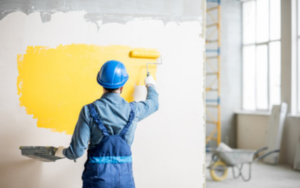
Source: U.S. Department of Labor, Bureau of Labor Statistics, May 2022
Description
These are two separate skills, but many craftsmen learn to do both. The methods of preparation and application are different, but both jobs are concerned with covering walls and surfaces. Painting includes the preparation of surfaces and the application of paint, varnish, enamel, lacquer, and similar materials to wood, metal, or masonry buildings. Painters may apply the paint with a brush, a spray gun, or a roller. They also mix pigments, oils, and other ingredients to obtain the required color and consistency. Paperhangers must also prepare surfaces. They have great skills to measure the surface, cut the wallpaper to size, paste, position and match designs, and work the air bubbles out to leave a smooth surface. A wide variety of specialized tools help throughout the process. They also learn to work with many fabrics, vinyl, or other materials.
Working Conditions
Painters work on floors, walls, ceilings, and equipment in interiors, and outside on everything from foundations to watertowers and flag-poles. Odors from paints, thinners, or shellac are usually present. Painters may work alone or in crews. Painters and paperhangers stand, stoop, turn, crouch, crawl, kneel and frequently climb scaffolds and ladders. Safety in this occupation depends on caution and safe practices while working.
Aptitude and Interest
Applicants should be able to work with numbers and work well with their hands. To qualify for some jobs the ability to distinguish between colors might be necessary.
Training
To become a skilled painter or paperhanger training is essential. It can be acquired informally through “learning-by-working;” through company on-the-job training programs; by attending trade or vocational/technical schools; through unilaterally (management or labor) sponsored trainee programs; through registered labor-management apprenticeship programs, or a combination of the above. It is generally accepted that the more formalized training programs give more comprehensive skill training. Recommended high school courses include art, chemistry, general shop, interior decorating, math, and woodwork finishing.